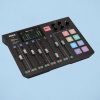
Review: Korg Volca Modular
Volca Modular is the world’s first battery-powered analogue semi-modular synth based on West Coast synthesis. Don’t be fooled, this is no one-trick pony nor dance muso’s bleep box but rather a playground for sonic experimentation.
When I first caught wind of the Volca Modular, I couldn’t help but wonder how Korg could squeeze over 50 patch points into the tiny Volca form factor. The answer is in the miniaturised DuPont pin-point headers — the left hand side for inputs (thin outline), the right hand side for outputs (solid outline). Connections intended for audio signals are denoted by a rounded outline. A generous 20 pin-patch cables are included of various lengths to get you started.
It’s ‘Modular’ by name but semi-modular by nature… mercifully so. It means the essential signal paths of Korg’s latest Volca are normalled internally such that with no patch cables connected, it will make basic tones, which is great news for those new to modular synthesis. (Normalled connections are indicated by grey line traces on the front panel.) Like I said, thanks goodness it’s semi modular, it means you can happily get lost down a rabbit-hole of patching, whip out all the patch wires, return to the normalled state and start making sound again.
Control voltage and audio signals throughout the unit operate within -3V to +3V for bipolar sources and 0V to +3V for unipolar sources and thus it’s safe to experiment with interchanging audio and control signals in a creative manner. Although the universe of Eurorack control voltages generally operate within the -5V to +5V range, a dual-channel CV input is provided on a single TRS minijack socket which allows control via CV and gate/trigger from external sources. Furthermore, it’s possible to cross patch between multiple Volca Modular units provided they are connected via the sync in/out connectors (providing a common ground reference) which is an exciting prospect.
RETURN TO THE SOURCE
The Source module contains a pair of Triangle VCOs which serve as a Carrier and Modulator respectively. With the normalled patch, only the Carrier (VCO1) is audible, however audio from the Modulator (VCO2) can be tapped from the patch header. Although it may appear a limitation to be armed with only Triangle waves, a continuous spectrum of harmonically complex waveshapes can be achieved via Wavefolding and linear Frequency Modulation. The Fold knob invokes Wavefolding on VCO1 and may be modulated externally. The Mod knob invokes Frequency Modulation between the Carrier and Modulator VCOs, the amount of which may also be modulated externally. The Ratio knob, with a range of 1:4 to 4:1, establishes the pitch offset of the Modulator wave — tweaking both Mod and Ratio knobs simultaneously reveals a wide range of tones.
Although a master tuning knob is absent, tuning is accomplished by holding down the Function button while tweaking the Ratio knob. During use I found having a dedicated tuner on hand to be essential.
FILTER & EFFECTS MODULES
In true West Coast fashion, a pair of independent Low Pass Gates (LPG) are on offer. These are similar to traditional VCFs but combine a VCA in circuit which has unique sonic characteristics (higher frequencies are enhanced with louder input). Unlike traditional VCFs, LPGs do not have resonance.
The intriguingly titled Space-Out module provides a stereo digital reverb-like effect with a simple Amount knob to control its level with an accompanying modulation input. While I found it useful for spicing up percussive sequences when firing triggers at it from the clock division outputs, you’ll probably reach for better-sounding reverb.
NEED TO KNOW
Korg Volca Modular
Semi-Modular Analogue Synth

FUNCTION MODULES
Rather than traditional ADSR envelopes, a pair of Function generators are provided: an Attack/Hold/Release (AHR) envelope and a Rise/Fall envelope. Inputs are provided to modulate the Attack/Release and Shape/Time for each Functionary generator respectively and both have positive and negative modulation outputs and end-of-cycle trigger outputs. The Rise/Fall function has a trigger input thus providing an LFO when patched to the end-of-cycle trigger output. While this may appear a crude means of providing an LFO, it is quite flexible since its frequency reaches into the audio frequency spectrum with tonal characteristics jointly affected by the shape and rate inputs, thus, serving as a third oscillator (with a largely sawtooth flavour).
UTILITY MODULES
A Clock module is hard-wired to drive the sequencer with a tempo ‘narrow’ range default of between 56 and 240bpm, however a Global setting allows a ‘wide’ option range of from 10bpm to 600bpm (useful when using the sequencer for creative effects rather than melodic duties). When not driven from the Sync Input, you can modulate the clock within a ±20bpm range. Trigger outputs are provided at /4, /3, /2 beat divisions. The Pitch/Gate and Trigger outputs are driven by the steps in the sequencer and thus the sequencer itself may serve as a modulation source.
The Split module provides a pair of passive signal splitters for creating mults of audio or control signals. When connected in reverse (inputs treated as outputs and vice versa), signals are summed, thus acting as a passive mixer.
The Woggle module provides a S&H circuit internally normalled to a Pink Noise generator which provides either stepped or slewed outputs. The noise source itself is not available as an audio source which I felt was a missed opportunity. When clocked at audio rates, while patched to other modules you can coax a range of distorted tones.
A ‘Math’ Utility module provides three inputs: A, B and C (with input C having an attenuation knob). Two Outputs allow signals to emerge simultaneously as either the result of A+BxC or A-BxC. Although you’d typically feed control voltages into this module, the real magic is found by feeding audio signals into the inputs – here you’ll find means of cross modulation and ring modulation which really expands its sonic palette.

THE SOUND
This synth excels at obscure, brash, raucous and otherworldly tones and drones. Musicians preoccupied with genres that embrace experimental textures will feel right at home. Due to its West Coast design, most notably with the absence of resonance in the filter section, the familiar sound palette typifying subtractive synths is absent from this unit, however it will lead you into new sonic territories.
MOD REAL
Volca Modular is West Coast synthesis for the masses. Essentially, it’s a stripped-down, low-cost, Buchla Music Easel to fit in your coat pocket, ready to tinker with anywhere and anytime. Although the modules within the Volca Modular are somewhat primitive just consider the package as a whole: for less than the price of many Eurorack oscillator modules, you get a useful sequencer capable of automating parameters, a pair of filters, a pair of envelopes, a passive splitter/mixer, a S&H module, math functions and basic spacial FX!
For musicians (like myself) yet to plunge into the obsessive universe of modular synths, this instrument is undeniably a gateway. Its creative potential can’t be underestimated for either exotic live jam sessions or as a miniature science-lab for generating original textures to sample into your DAW. Although its sound won’t be for everyone, if you’re looking to expand your sound design vocabulary beyond traditional subtractive synths, Volca Modular is well worthy of your attention.


MOD REAL
Volca Modular is West Coast synthesis for the masses. Essentially, it’s a stripped-down, low-cost, Buchla Music Easel to fit in your coat pocket, ready to tinker with anywhere and anytime. Although the modules within the Volca Modular are somewhat primitive just consider the package as a whole: for less than the price of many Eurorack oscillator modules, you get a useful sequencer capable of automating parameters, a pair of filters, a pair of envelopes, a passive splitter/mixer, a S&H module, math functions and basic spacial FX!
For musicians (like myself) yet to plunge into the obsessive universe of modular synths, this instrument is undeniably a gateway. Its creative potential can’t be underestimated for either exotic live jam sessions or as a miniature science-lab for generating original textures to sample into your DAW. Although its sound won’t be for everyone, if you’re looking to expand your sound design vocabulary beyond traditional subtractive synths, Volca Modular is well worthy of your attention.
























RESPONSES